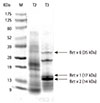1. Oh JW, Lee HB, Kang IJ, Kim SW, Park KS, Kook MH, et al. The revised edition of korean calendar for allergenic pollens. Allergy Asthma Immunol Res. 2012; 4:5–11.

2. The Angiosperm Phylogeny Group. An update of the angiosperm phylogeny group classification for the orders and families of flowering plants: APG II. Bot J Linn Soc. 2003; 141:399–436.
3. Niederberger V, Pauli G, Gronlund H, Froschl R, Rumpold H, Kraft D, et al. Recombinant birch pollen allergens (rBet v 1 and rBet v 2) contain most of the IgE epitopes present in birch, alder, hornbeam, hazel, and oak pollen: a quantitative IgE inhibition study with sera from different populations. J Allergy Clin Immunol. 1998; 102(4 Pt 1):579–591.

4. Park HS, Chung DH, Joo YJ. Survey of airborne pollens in Seoul, Korea. J Korean Med Sci. 1994; 9:42–46.

5. Lee JW, Choi GS, Kim JE, Jin HJ, Kim JH, Ye YM, et al. Changes in sensitization rates to pollen allergens in allergic patients in the Southern part of Gyeonggi province over the last 10 years. Korean J Asthma Allergy Clin Immunol. 2011; 31:33–40.
6. Oh JW, Lee HB, Lee HR, Pyun BY, Ahn YM, Kim KE, et al. Aerobiological study of pollen and mold in Seoul, Korea. Allergol Int. 1998; 47:263–270.

7. Oh JW. Development of pollen concentration prediction models. J Korean Med Assoc. 2009; 52:579–591.

8. Movérare R, Westritschnig K, Svensson M, Hayek B, Bende M, Pauli G, et al. Different IgE reactivity profiles in birch pollen-sensitive patients from six European populations revealed by recombinant allergens: an imprint of local sensitization. Int Arch Allergy Immunol. 2002; 128:325–335.

9. Ebner C, Hirschwehr R, Bauer L, Breiteneder H, Valenta R, Ebner H, et al. Identification of allergens in fruits and vegetables: IgE cross-reactivities with the important birch pollen allergens Bet v 1 and Bet v 2 (birch profilin). J Allergy Clin Immunol. 1995; 95(5 Pt 1):962–969.

10. Kim KH, Kim KT, Lee SK, Park HS, Lee YM, Nahm DH, et al. Sensitization rates for inhalant allergens in patients with respiratory allergy in Busan. Korean J Asthma Allergy Clin Immunol. 2005; 25:59–63.
11. Smith M, Emberlin J, Stach A, Czarnecka-Operacz M, Jenerowicz D, Silny W. Regional importance of Alnus pollen as an aeroallergen: a comparative study of Alnus pollen counts from Worcester (UK) and Poznań (Poland). Ann Agric Environ Med. 2007; 14:123–128.
12. Pauli G, Oster JP, Deviller P, Heiss S, Bessot JC, Susani M, et al. Skin testing with recombinant allergens rBet v 1 and birch profilin, rBet v 2: diagnostic value for birch pollen and associated allergies. J Allergy Clin Immunol. 1996; 97:1100–1109.

13. Jarolim E, Rumpold H, Endler AT, Ebner H, Breitenbach M, Scheiner O, et al. IgE and IgG antibodies of patients with allergy to birch pollen as tools to define the allergen profile of Betula verrucosa. Allergy. 1989; 44:385–395.

14. Valenta R, Duchene M, Pettenburger K, Sillaber C, Valent P, Bettelheim P, et al. Identification of profilin as a novel pollen allergen; IgE autoreactivity in sensitized individuals. Science. 1991; 253:557–560.

15. Valenta R, Duchene M, Ebner C, Valent P, Sillaber C, Deviller P, et al. Profilins constitute a novel family of functional plant pan-allergens. J Exp Med. 1992; 175:377–385.

16. van Ree R, Voitenko V, van Leeuwen WA, Aalberse RC. Profilin is a cross-reactive allergen in pollen and vegetable foods. Int Arch Allergy Immunol. 1992; 98:97–104.

17. Huh JE, Baek YH, Kim YJ, Lee JD, Choi DY, Park DS. Protective effects of butanol fraction from Betula platyphyla var. japonica on cartilage alterations in a rabbit collagenase-induced osteoarthritis. J Ethnopharmacol. 2009; 123:515–521.

18. Park JW, Hong CS, Yun YY, Ko SH. Cross - reactivity between pollens in patients sensitlzed to multiple pollens. J Asthma Allergy Clin Immunol. 1999; 19:584–593.
19. Mothes N, Horak F, Valenta R. Transition from a botanical to a molecular classification in tree pollen allergy: implications for diagnosis and therapy. Int Arch Allergy Immunol. 2004; 135:357–373.










 PDF
PDF ePub
ePub Citation
Citation Print
Print



 XML Download
XML Download